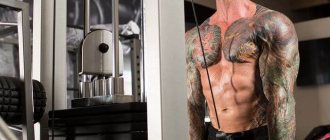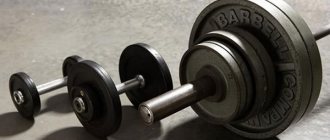13 May 2021 Admin Home page » Tips and tricks
Find out all the pros and cons of training to failure, important tips and tricks, when you can use failure and what the cost of using it incorrectly is.
Improper use of training to failure can lead to a halt in muscle growth, while its proper use stimulates anabolism and an increase in muscle volume. Let's clarify the situation around the type of failure and what scientific research has been carried out.
Training to failure
In the field of fitness and bodybuilding, the opinions of different experts are divided, some shout that muscle failure is the path to glory, a striking example is the king of bodybuilding Arnold Schwarzenegger, he claims that it is the last 2-3 repetitions that activate and make muscles grow, that’s the only way you can break through dormant muscle areas. It is by crossing the “I can’t” threshold that the path to Olympus opens and this distinguishes ordinary people from champions.
Other experts insist that this is useless work that leads to total overtraining, which puts a barrier to muscle progress. After all, the main thing is to pump the muscle well, fill it with blood, nutrients and oxygen.
So how can you get the most out of training to failure with minimal losses?
Who came up with the idea of training to failure?
Until the mid-70s of the last century, all bodybuilders unconditionally submitted to the concept of high-volume training - long-term training with a large number of exercises and approaches. The motto of this concept was: “The more, the better.” There was no talk of any failure with this style of training, because strength runs out very quickly when performing failure sets.
The inventor of the Nautilus simulators, Arthur Jones, opposed the system. He proposed an alternative theory - high-intensity training, the motto of which was diametrically opposed: “Less is better.” One of the main principles of his theory was that a set completed before the point of failure does not engage all available muscle fibers (fast and slow), and therefore does not provide maximum stimulation for muscle growth.
This is where the history of training to failure began. Jones's theory was immediately harshly criticized and continues to be criticized to this day, but it was she who raised such athletes as six-time Mr. Olympia Dorian Yates and Olympia silver medalist Mike Mentzer.
When to Apply a Waiver
Despite the opinion of proponents against the use of refusal, research conducted by strength specialist Brad Schoenfeld has proven that increasing lactic acid concentration has a direct effect on stimulating muscle growth due to increased production of intramuscular growth factor. And much more lactic acid is produced just when muscle failure is reached.
The big advantage of working to failure is that working to the limit, small muscle areas quickly get tired, this forces the nervous system to send a command to large, fast-twitch muscle fibers to start working.
But at the same time, a big minus immediately appears, having completed the approach to complete failure, the emotional state is greatly depleted, having completed a set of 8 repetitions, you are unlikely to do the next one again for 8 repetitions, most likely the work will go according to the following scenario - then perform it for 7-6, and then for 4-5 repetitions.
In this connection, it is recommended to work to failure, only in the last 1-2 sets of the exercise, this will lead to an increase in muscle mass and strength and will not cause a stop in muscle progress.
Advantage of Muscle Failure
- Stimulates muscles to grow . As everyone knows, during training we injure our muscles, namely muscle fibers, causing them microtrauma. During rest, the muscles recover, becoming stronger and larger, so that the next time they are ready for this type of load. By reaching muscle failure, we injure the muscles more, and thereby motivate them to grow.
- Stimulation of hormone production . When we train to failure, we subject our body to intense physical stress. To adapt to this, our body stimulates the production of anabolic hormones.
- Muscle failure only in the last approach . So says Mike Mentzer, star of the golden era of bodybuilding. He was one of the first to practice this approach to training in bodybuilding. So, he believed that it is not necessary to achieve muscle failure in every set. It is best to end the exercise (last approach) with muscle failure.
Consequences of failure
The fact that training to failure exhausts our body is an indisputable fact that cannot be ignored. Scientific research conducted by Spanish specialists has proven that working hard helps to increase the level of the nucleotide adenosine monophosphate (NAM), because of which the cell experiences an energy deficit, which reduces the level of protein synthesis.
The Spaniards also put forward a scientifically based theory that refusal activates the hormone Cortisol, which triggers a muscle resolution mechanism (catabolic processes), which in turn stops the process of muscle growth in the long term.
In order to prevent this, muscle failure must be used from time to time to allow the body to recover well and not drive itself into muscle stagnation.
Different views on the effect of muscle failure
As with any activity, there are many schools of thought and teachings in bodybuilding. Fans of one of them are sure that the bulk of an athlete’s mass is built thanks to relatively light weights and a large number of repetitions. And representatives of another direction are sure that muscle growth occurs only thanks to critical weights and a small number of approaches. By the way, Arthur Jones, the creator of the Nautilus simulator, also belongs to this group.
Fans of the second direction are sure that during training it is necessary to work so much until the exercise is impossible to complete even partially. There have been many conflicts between representatives of these schools and now is the time to summarize all the existing experience and find out what is really happening.
What's beyond failure?
Many people wonder how you can move beyond muscle failure, what lies beyond it?! Unfortunately, our body cannot influence failure when our arms refuse not only to lift the barbell, but simply to bend our arms.
But there are several good methods in your arsenal:
Pumping – thanks to which you can take small weights and additionally fill the muscles with blood, causing them to swell before your eyes.
Forced repetitions are a real masochist when you perform a given number of repetitions, and then you are slightly helped at the beginning of the lift by the last 2-3 repetitions, which you lower yourself.
Negative repetitions - when your body refuses to lift the weight at all, they lift it completely for you, you only lower it, concentrating your efforts on the negative phase.
Drop sets - having completed, for example, the planned number of 8 repetitions, reduce the weight by 20-25% and do the same 8 repetitions again and so on until the end, after which your arms will burn and burst, reaching mega failure.
Using these methods of continuing refusal, you just want to shout at the end - “Mom, give me birth back, what am I doing here.”











